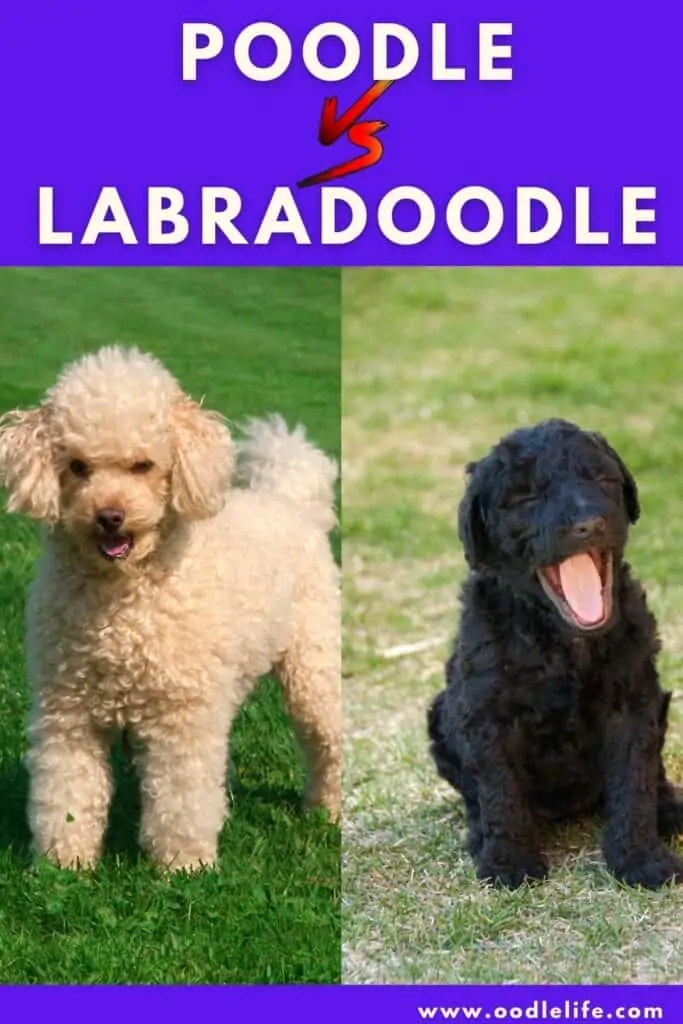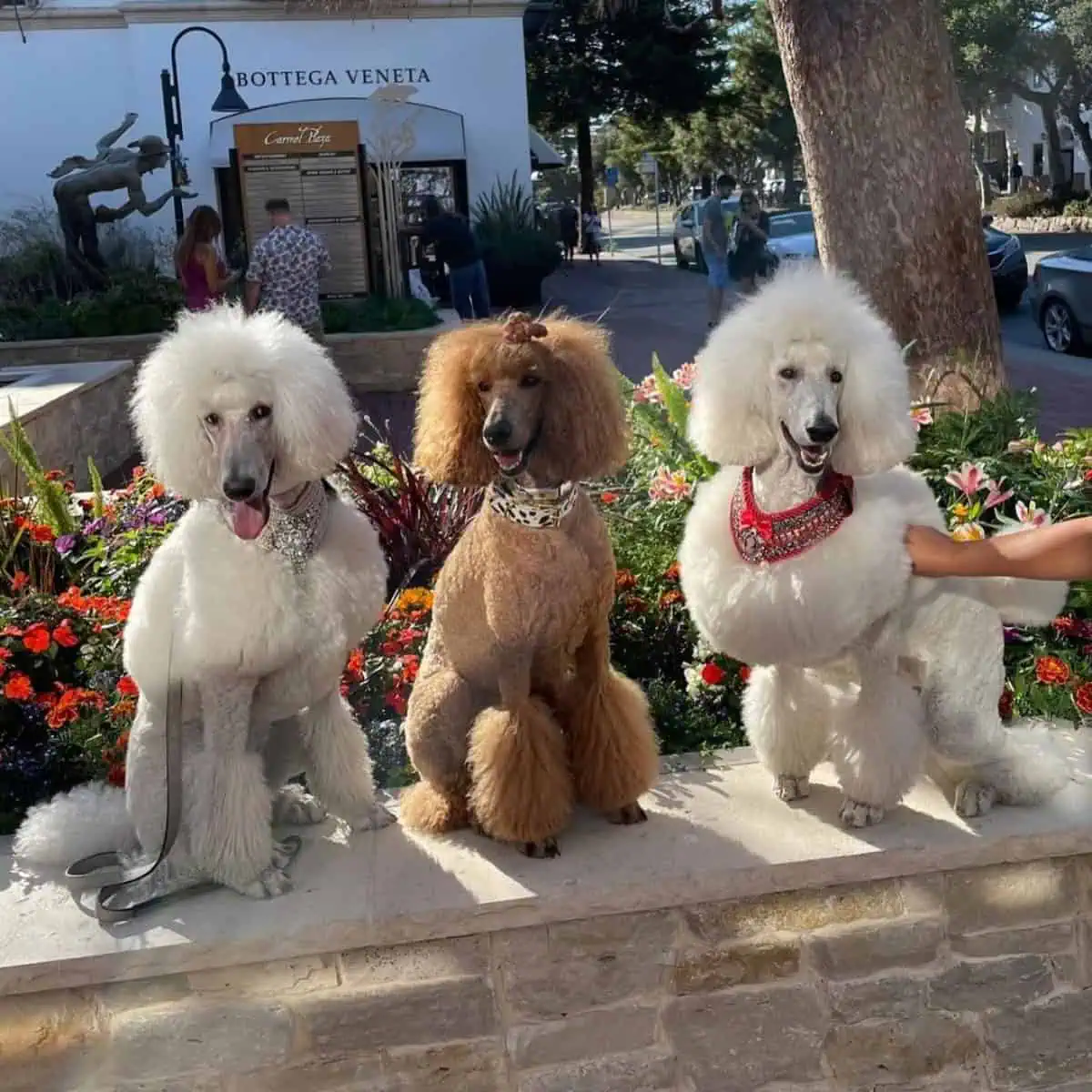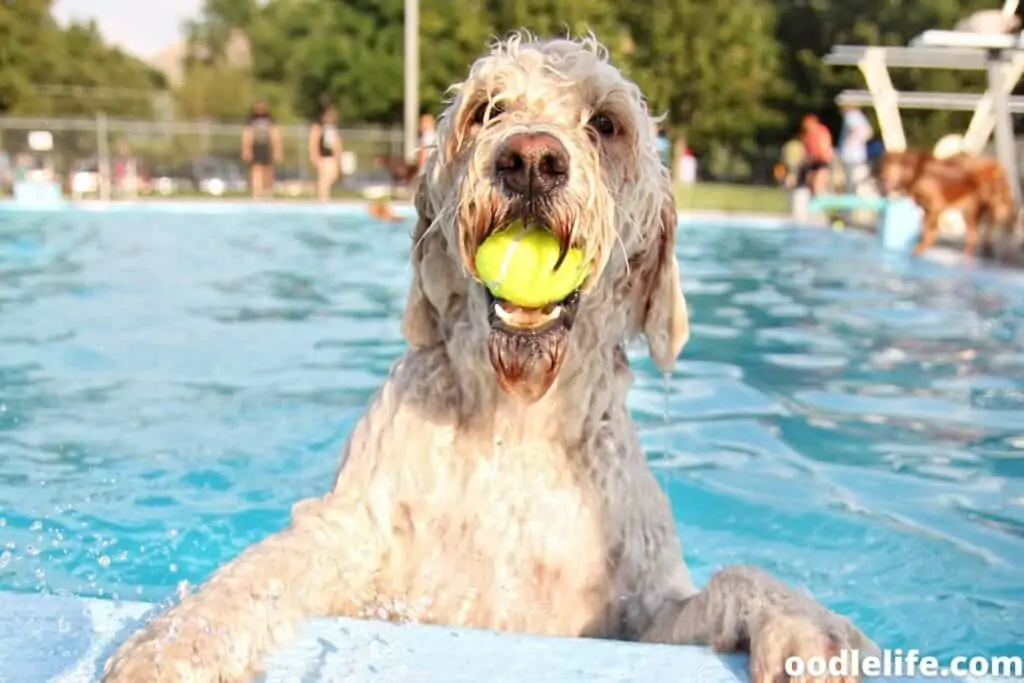Poodle vs Labradoodle – A Breed Comparison
When it comes to designer dogs, the poodle is one of the most popular parent breeds. It’s made contributions to multiple different designer breeds that are well known and loved worldwide.
Just like with human children, parent breeds and the resulting mixed breeds can share many characteristics but are distinct and separate from each other at the end of the day.

The Labradoodle is one such designer breed that shares certain qualities with one of its parent breeds, the poodle. Both have appealing qualities that make them wonderful family pets.
However, when it comes down to a choice, which breed is best for you? While they can be similar, the two breeds do have differences that make them distinct and can help you determine which one would make the best addition to your family.
Appearance
While we all know not to judge a book by its cover, appearance is an important part of what makes both of these dogs so unique.

Coat
Poodles display a standard, curly coat that is famous for its hypoallergenic and non-shedding qualities because of its single-layer growth pattern. These special characteristics are some of the major reasons why the poodle has been chosen as a parent breed for so many designer breeds.
Labradoodles can inherit a similar coat from their poodle parent, but this isn’t always the case. As with any designer breed, the characteristics of the resulting dog can vary between each parent, favoring one more than the other in some cases. Pups’ appearances can even vary within the same litter.
Labradoodles will have one of three coat types: hair, fleece, or wool. Labradoodles with a hair coat display a wavy pattern that varies in length and thickness. This coat style resembles a labrador than a poodle, so it falls between the two breeds in terms of shedding.
Also, F1 Labradoodles, or dogs with a labrador parent and a poodle parent, are most likely to have this type of coat.
The wool coat is the closest labradoodle coat to that of the poodle. It is dense and has very little or no undercoat at all, meaning that these dogs shed the least of all Labradoodles. Given the name, this coat resembles sheep’s wool and even behaves a bit like it: it retains some of the water-resistance of the poodle’s coat.
Last is the fleece coat, which is in between the wool and hair coats. This is the most popular coat for Labradoodles, as it’s very silky and light but still offers minimal shedding. This coat type can vary in styles: thick or fine, wavy or straight, or even curly.
All coat types require a varying level of upkeep, although the wool coat is the closest to the poodle coat in terms of minimal shedding, waterproof quality, and appearance.

Size Differences of Poodle vs Labradoodle
There is also a notable size difference between these two breeds. The standard poodle stands fifteen inches at the shoulder and can weigh from forty-five to seventy pounds.
Although this is a medium to large size for a dog, the poodle displays a lean build suited to its original purpose as a waterfowl hunting dog.
The labradoodle, while technically in a similar size range as its poodle parent, has a different build thanks to its labrador parent. Labradoodles can get up to twenty-four inches tall at the shoulder but will weigh on average around fifty to sixty-five pounds.
They tend to have a more muscular and sturdy build than poodles. Although both their parent breeds have large chests thanks to their original purpose as working dogs, the labradoodle’s proportions are often a little different than the poodle.
Whereas poodles have longer, leaner legs in relation to their frame, Labradoodles often take after their labrador parents with an overall more balanced proportion that makes them seem stockier.

Temperament
Both dogs display athleticism, intelligence, and loyalty to their people, but they do have key points of difference within their respective personalities.
Although their regal appearance can make them seem somewhat aloof, Poodles are playful and energetic and make great family dogs. However, they are shyer when it comes to new people or even other animals.
On the other hand, the Labradoodle inherits from its Labrador parent an outgoing and friendly nature. Their happy-go-lucky attitudes help them make new friends easily.
Both breeds are very active and need regular exercise and mental stimulation to stay happy and healthy. However, some Labradoodles may be calmer and less active than their Poodle parents. As mentioned above, this can vary between individuals even within the same litter.
In terms of intelligence, Poodles can exhibit more stubborn behavior and may be harder to train than Labradoodles, but both breeds adore their people and make loyal companions.

Health and Life Expectancy
Whereas many large-sized breeds can expect shorter lifespans, both the poodle and the labradoodle both enjoy longer lifespans than most other dogs their size. While poodles live on average a little over eleven years, the average for Labradoodles is around twelve.
Of course, this is only an average, and individuals have been known to live as long as fifteen and sixteen years with the proper care.
Even though they are, on average, long-living dogs, they can both be prone to certain health issues. Poodles are especially susceptible to hormone-related diseases, such as Cushing’s disease and Addison’s disease, both of which affect cortisol and the adrenal glands.
These illnesses can impact the poodle’s anxiety levels and heighten their fight or flight response instincts.
Poodles can also suffer from a variety of joint issues, specifically in the kneecap and hip. However, one of the most common poodle maladies is sebaceous adenitis, which affects over 50% of standard poodles who either suffer from it or carry it. This disease causes patchy fur as well as skin dryness.
The Labradoodle can inherit some of the poodle’s joint issues, including elbow and hip dysplasia. Likewise, they can be prone to adrenal gland issues. Otherwise, though, Labradoodles are known to generally be somewhat healthy dogs, depending on the health history of their respective parents.

Needs of Poodle Vs Labradoodle
If you’re looking for a low-maintenance dog, neither breed is going to fit the bill. Both the poodle and the labradoodle require upkeep in multiple different areas.
In terms of grooming, both breeds require regular trips to the groomer, although the style of cut will vary based on the coat type and the owner’s preference. Depending on which kind of labradoodle you get, less grooming may be necessary, but this isn’t always the case.
Both breeds are large breed dogs, meaning that they both require adequate space. As active dogs with working-breed history, they will both need plenty of space to run and exercise and get their energy out, or else they can be prone to acting out.
When it comes to training, the poodle often needs more time and effort because of its more headstrong nature. While Labradoodles are known to be calmer and easier to train, both breeds are highly intelligent and need early intervention for proper training and socialization.
Mental stimulation is also an important need for both breeds. Neither will be happy sitting in the house all day and will require time and effort from their owners to keep them engaged and happy and to keep them from developing destructive behaviors.

Cost
As both of these breeds are popular and highly sought-after, the cost of purchasing a puppy from a breeder will be around the same. The main difference is that the poodle is recognized by the AKC with several breed sizes. On the other hand, the labradoodle, like many designer dogs, is not yet recognized.
Still, the popularity of these dogs means that you can expect to pay upwards of $1000 for a puppy across both breeds.
While poodles come in a variety of three AKC-recognized breed sizes, Labradoodles can be either F1 (50% poodle and 50% labrador), F1B (75% poodle and 25% labrador), or F2 (87% poodle and 13% labrador). This variation is possible when mixing poodle parents with either a labrador parent or different labradoodle parents.

Final Thoughts
Both the poodle and the labradoodle are highly popular dogs who are greatly sought after as pets for many different reasons. They share traits like intelligence, an active lifestyle, and loyalty.
They also have similarities in appearance, as they fall within the same size range and, depending on the type of coat, can have similar non-shedding properties and grooming requirements.
They also share similar life expectancies and health issues. However, these breeds are unique, and their differences make them distinct.
Poodles are far more reserved and shy, while Labradoodles are outgoing and friendly. Labradoodles are the stockier dogs, and poodles have a leaner appearance. A poodle will prove harder to train, and Labradoodles are more likely to be laid back.
At the end of the day, both breeds make excellent pets for slightly different families and homes. Breeds also vary from individual to individual, so whether you opt for a poodle or a labradoodle, make sure to consider the breed’s characteristics and needs, and you’ll have a loyal companion for years to come.